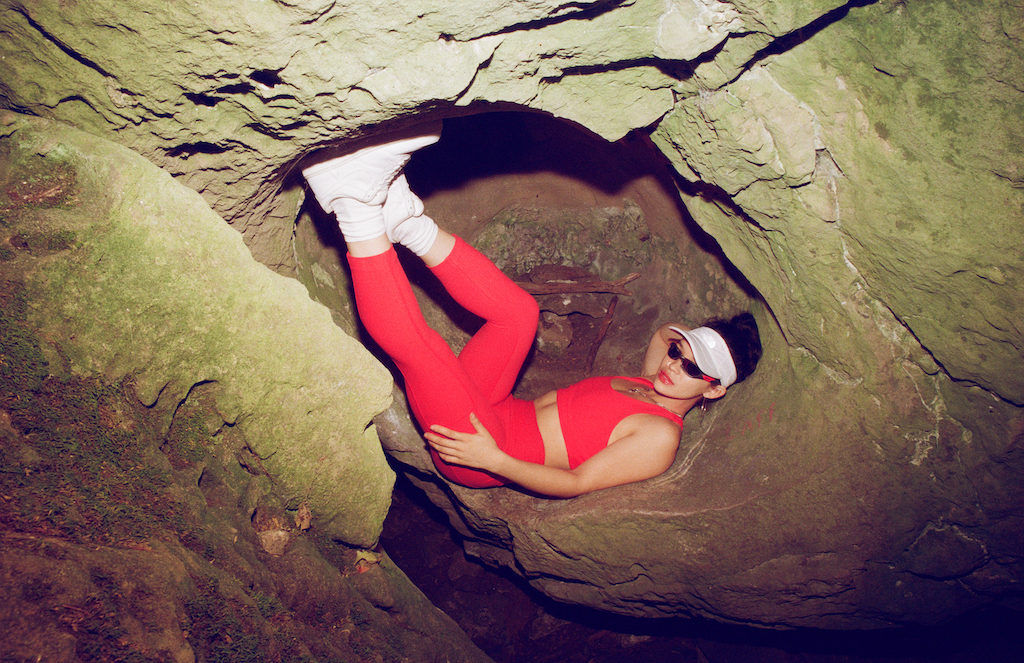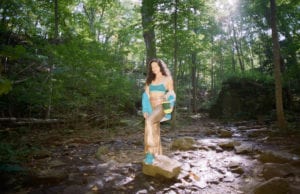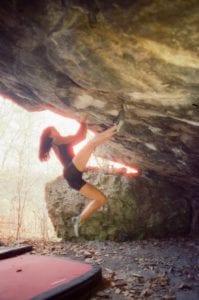Canada’s Fashion Focused Climbing Photography
Climbing photography often focuses on performance, but Ontario photographer Ilya Sarossy has set her sights on climbing fashion through film
 Photo by: Ilya Sarossy of Pia Graham
Photo by: Ilya Sarossy of Pia Graham
Historically, climbing photography has gone through numerous changes. The last two decades have largely focused on performance and a climb’s most essential moments. The increasing quality of cameras has allowed for photographers to describe the intensity of attaining a crux hold, while competition climbing’s explosion has developed a newly popular genre of competition-focused images.

No matter the discipline, the highly-dynamic sport has made climbing an exciting subject to capture. It has focused on difficulty and progression as the level increased over these last decades. Even today, the world’s best continue to establish heinous and challenging routes while the upper limit of the sport becomes more difficult to define. Still, climbing no longer exists exclusively in the microcosm of performance. With international recognition, climbing has expanded beyond the bounds of athleticism.
Ontario photographer Ilya Sarossy has worked to capture the climber within the context of their style. Although style has generally referred to a type of movement, Sarossy has approached the subject through a more fashionable lens. “I always wanted to do something that was fashion focused for climbing because I think fashion is such a fundamental part of the community. Even though it’s not talked about as such, I think a lot of climbers showcase their identities through the clothes that they wear.”
This perspective reflects in the changing styles of climbers, their philosophies, and their associations with the movements of their eras. Many climbers will relate to finding their psych due to the incredible films of the last 10 years. Valley Uprising offered a lifestyle approach to the sport that attracted many. It offered a highly-stylized view of hippy athletes camping in Yosemite.
The 80s brought with it their own brand of film-based aesthetic, while the 90s centred itself around an almost punk-rock style of climbing clothes, film production, and athletics. The 2000s saw the progressive increase of modern athletes and Chris Sharma revitalized a Californian aesthetic that came across through his 5.10 Moccasyms, relaxed countenance, and passion-based lifestyle.
The last 11 years have seen the aesthetic develop even further. Competition climbing not only became more popular in North America, but it has developed the sport into an Olympic-level discipline. Alongside this development, the dirt-bag aesthetic has found itself replaced by a more European-style of competition-like climbing clothes. All of a sudden, a person might enter the gym in E9 pants and comp-designed climbing shoes with a style that does not appear in any other part of North American outdoor culture.
In sports like surfing and skateboarding, this development has already occurred. The skating aesthetic has become so widespread that performance bouldering has adopted aspects of it. Look at Mellow. Furthering this point, climbing-bred brands like Arc’teryx have put an increased focus on their streetwear while The North Face has released high-fashion models of their more famous products.
So Ill has also produced street shoes in association with Toms that target a larger aesthetic market than the hard-core climber. Even Adidas has worked itself into the climbing sphere through the acquisition of Five Ten.

That sphere is not exclusive to athletic merchandise either. Agent Provocateur’s feature with Sasha DiGiulian represents climbing’s elevation to a high-fashion plane of existence. Sarossy’s work with her recent fashion-forward series moves beyond a marketing perspective into a more creatively-styled depiction of climbing photography.
Sarossy has worked in film and photography from a young age. Raised by an actress and a director, Sarossy travelled with her parents around the world on film shoots. Upon entering university, she would begin climbing and its associated photography with a focus on action-packed images defined by her subjects.
With lockdown, Sarossy would take climbing photos within the context of editorial images for an eyewear company. As her love for climbing increased with her editorial experience, she would experiment with melding the two disciplines. The more photos she took, the more she realized that the audience often only sees an aspect of a climber in conventional media. Sarossy took aim at describing the person behind the climber. This would lead to her Walls of Honey photo shoot.

Working closely with subject Pia Graham, Sarossy would develop the aesthetic that she hoped could capture multiple aspects of her subject. “I think that each climber has a different relationship to both the sport and how connected they feel to fashion. It’s fun to plan the shoot with them and work closely on the day to make sure that they feel powerful, gorgeous and represented by what I’m doing when I’m shooting them.”
Sarossy worked with Graham to find the aesthetic that would work best for them. “My intention when I work with my subjects, is to craft a style that reflects their identity and what they’re excited by. For Pia, we leaned into the 80s because that’s an aesthetic that excited her. Fashion has always been an art form, it is a really powerful tool for self-expression that everyone participates in, and I want my photos to reflect every climber I shoot with.”
The fact that this shoot became published in the fashion-focused Gezno Magazine shows how climbing can offer a stylized experience. After this original success, Sarossy would work closely with competition climber Zoe Beauchemin to further explore the discipline.

Sarossy noted how the differences in the women and their relationships to the sport influenced the ways in which she approached each shoot. “I really tried to change up how we did the shoot to make sure that all the women felt a sense of self in their images. Authenticity is important to me. I want to make sure that the end result is a connection to what the subject and I were experiencing at the moment.”
Part of Sarossy’s attraction to fashion-focused climbing photography comes from the individual nature of the sport. “I think that climbing is an activity that reflects the person doing it. So if that person is stylistically bold or glamorous than that will be reflected in their interactions with climbing.”
Although this individuality normally presents through the psych of the world’s strongest, Sarossy believes that this alternative perspective offers an interesting window into some of climbing’s unique personalities. “As artists, it is our duty to push the envelope in the way that we represent our subjects. I wanted to show that expressing femininity in this sport, or any form of individuality that falls outside the norm, does not mean that a lack of strength or power.”
Unlike many of the climbing photos around today, Sarossy, so far, has focused her climbing-fashion photography through the lens of 35-millimetre film. Her attraction to film comes down to the necessary preparations required to feature the subject correctly.
Naturally, Sarossy still takes great joy from shooting high-quality, high-octane digital photos of the sport; however, these fashion-focused photos might indicate a new stylized direction for climbing as it enters the mainstream.
Check out more of Sarossy’s work here.



